Related Research Articles

Magnus Maximus was Roman emperor of the Western Roman Empire from 383 to 388. He usurped the throne from emperor Gratian.

Uther Pendragon (Brittonic), also known as King Uther, was a legendary King of the Britons and father of King Arthur.

Vortigern, also spelled Vortiger, Vortigan, Voertigern and Vortigen, was a 5th-century warlord in Britain, known perhaps as a king of the Britons or at least connoted as such in the writings of Bede and Gildas. His existence is contested by scholars and information about him is obscure.

Mordred or Modred is a figure in the legend of King Arthur. The earliest known mention of a possibly historical Medraut is in the Welsh chronicle Annales Cambriae, wherein he and Arthur are ambiguously associated with the Battle of Camlann in a brief entry for the year 537. Medraut's figure seemed to have been regarded positively in the early Welsh tradition and may have been related to that of Arthur's son.
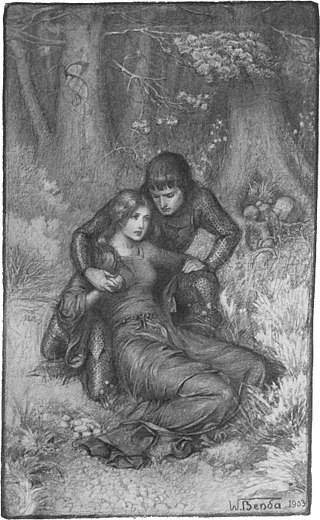
In the Matter of Britain, Igraine is the mother of King Arthur. Igraine is also known in Latin as Igerna, in Welsh as Eigr, in French as Ygraine, in Le Morte d'Arthur as Ygrayne—often modernised as Igraine or Igreine—and in Parzival as Arnive. She becomes the wife of Uther Pendragon, after the death of her first husband, Gorlois.
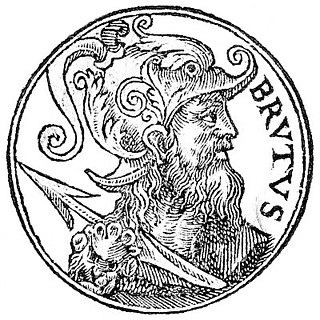
Brutus, also called Brute of Troy, is a legendary descendant of the Trojan hero Aeneas, known in medieval British legend as the eponymous founder and first king of Britain. This legend first appears in the Historia Brittonum, an anonymous 9th-century historical compilation to which commentary was added by Nennius, but is best known from the account given by the 12th-century chronicler Geoffrey of Monmouth in his Historia Regum Britanniae.
Estrildis was the beloved mistress of King Locrinus of the Britons and the mother of his daughter Habren, according to the 12th-century chronicler Geoffrey of Monmouth.
Gwendolen, also known as Gwendolin, or Gwendolyn was a legendary ruler of ancient Britain. She is said to have been queen during the 11th century BC.

Leir was a legendary king of the Britons whose story was recounted by Geoffrey of Monmouth in his pseudohistorical 12th-century History of the Kings of Britain. According to Geoffrey's genealogy of the British dynasty, Leir's reign would have occurred around the 8th century BC, around the time of the founding of Rome. The story was modified and retold by William Shakespeare in his Jacobean tragedy King Lear.
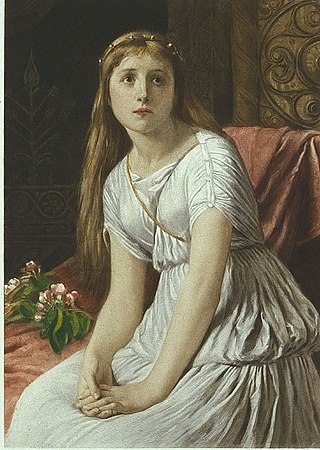
Cordelia was a legendary Queen of the Britons, as recounted by Geoffrey of Monmouth. She was the youngest daughter of Leir and the second ruling queen of pre-Roman Britain. There is no independent historical evidence for her existence. She is traditionally identified with the minor character Creiddylad from Welsh tradition, but this identification has been doubted by scholars.
Sisillius I was a legendary king of the Britons as accounted by Geoffrey of Monmouth. He was preceded by Gurgustius and succeeded by Jago. He was the father of Kimarcus, king of the Britons, and shares his name with one of the sons of Ebraucus, and two later kings of the same name. Geoffrey has nothing to say of him beyond this.
Kimarcus was a legendary king of the Britons according to Geoffrey of Monmouth. He was the son of Sisillius I and was succeeded by Gorboduc. Geoffrey has nothing to say of him beyond this.
Guithelin was a legendary king of the Britons as accounted by Geoffrey of Monmouth. He became king after the death of Gurguit Barbtruc.
Sisillius II was a legendary king of the Britons as recounted by Geoffrey of Monmouth.

Historia regum Britanniae, originally called De gestis Britonum, is a pseudohistorical account of British history, written around 1136 by Geoffrey of Monmouth. It chronicles the lives of the kings of the Britons over the course of two thousand years, beginning with the Trojans founding the British nation and continuing until the Anglo-Saxons assumed control of much of Britain around the 7th century. It is one of the central pieces of the Matter of Britain.
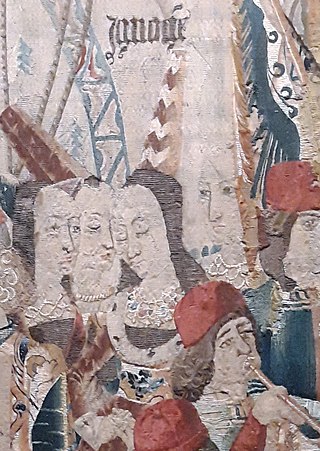
Innogen is a character in the Historia Regum Britanniae and subsequent medieval British pseudo-history. She was said to have been a Greek princess, the daughter of King Pandrasus, and to have become Britain's first Queen consort as the wife of Brutus of Troy, the purported first king of Britain who was said to have lived around the 12th century BC. Her sons Locrinus, Camber, and Albanactus went on to rule Loegria, Cambria, and Alba respectively.

Jago was a legendary king of the Britons according to Geoffrey of Monmouth. He was the nephew of Gurgustius, succeeded his cousin Sisillius I to the throne and was succeeded by Sissillius' son Kimarcus. Geoffrey has nothing more to say of him.

Rowena in the Matter of Britain was the daughter of the purported Anglo-Saxon chief Hengist and wife of Vortigern, "King of the Britons". Presented as a beautiful femme fatale, she won her people the Kingdom of Kent through her treacherous seduction of Vortigern. Contemporary sources are nearly non-existent, so it is impossible to know if she actually existed.
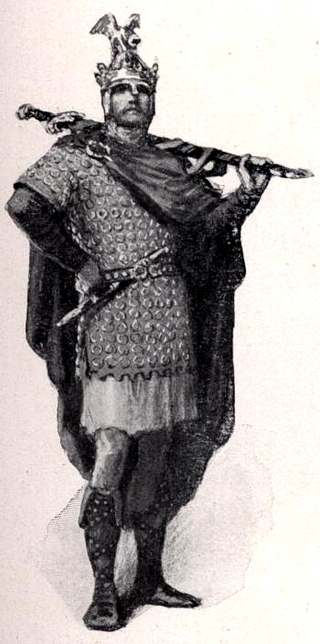
King Arthur's family grew throughout the centuries with King Arthur's legend. Many of the legendary members of this mythical king's family became leading characters of mythical tales in their own right.
References
- 1 2 3 Geoffrey of Monmouth (1842) [c. 1136]. . In Giles, J. A. (ed.). The British History of Geoffrey of Monmouth in Twelve Books. The monkish historians of Great Britain. Vol. 3. Translated by Thompson, Aaron. London: James Bohn. pp. 54–55. hdl: 2027/mdp.39015002171711 .
- 1 2 Barefield, Laura D., Gender and History in Medieval English Romance and Chronicle, Peter Lang, New York, 2003, p.27.
- 1 2 3 Cooper, B. "History of the Early British Kings" . Retrieved 2011-02-07.